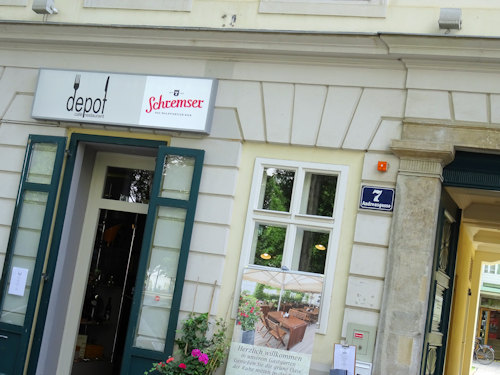If you prefer mobile thrones to mobile phones, then the Vienna Furniture Museum (Möbelmuseum Wien) is for you.
Think of the museum as the Antiques Roadshow on speed, where the desks come with mahogany and pearl inlays, not a screwdriver and assembly instructions.
- View beds, chairs, cabinets, etc. that graced imperial residences
- …especially from 1800 onwards
- Displays focus on Habsburg personalities
- Also covers later furniture design eras
- What special exhibitions are on?
- See also:
- Furniture Museum highlights
- The Vienna Pass (gives one-time free entry)
Inside the Möbelmuseum

(Formerly the imperial furniture collection)
The Möbelmuseum Wien essentially takes you on two journeys.
The first is a sojourn through the furniture associated with imperial palaces and personalities. The items radiate opulence and history.
The second is a wander through a loose chronology of furniture design in Austria, with emphasis on key eras like the Biedermeier or Wiener Moderne.
Here’s a quick overview of what to expect, with some personal highlights listed elsewhere.
Habsburgs & their homes

Secretaire once owned by Marie Antoinette © BMobV, Photo: Lois Lammerhuber
The first floor at the entrance is where most of the upholstered action is, beginning with an introduction to imperial furniture management.
You know how moving house can be rather stressful? Now imagine that when your house has over 1400 rooms.
The exhibition then introduces you to the depth of the museum’s imperial collection through a cornucopia of items that extends from an Egyptian-themed mini glasshouse for cacti to coat stands and candelabras.
We also learn of the museum’s activities in a post-Habsburg world, such as research and providing props for period films.
The rest of the rooms on this floor then present displays associated with some of the iconic Habsburg personalities, their homes and their family members (with an emphasis on the 1800s and later). Not just furniture, but “memorabilia” too, such as funeral crowns and chess sets made of rosewood and ivory.
As you move from display to display you develop a feeling for the changing culture, from the rich decoration of Marie Antoinette’s 18th century secretaire (a drop-front writing desk) to the more functional sleekness of the 19th century era as displayed in Emperor Franz II/I’s study.
You also gain some insight into the personalities of the owners, as reflected in their choice of styles and designs. So you see Crown Prince Rudolf’s Turkish room or tortoiseshell and brass furniture from Empress Elisabeth’s Achilleion villa in Corfu.
Talking Elisabeth, the museum highlights those items associated with the life of Sisi (as she was known), including the furniture and accoutrements used in movie versions of her life (with illustrative film clips).
Biedermeier & beyond

(Biedermeier period room in the Vienna Furniture Museum; press photo © Schloß Schönbrunn Kultur- und Betriebsges.m.b.H / Severin Wurnig)
The next floor houses the special exhibitions but also features, for example, a typical early 19th century music room and salon that would not look out of place in a Jane Austen adaptation.
This display of period rooms continues on the third floor, with a row of examples from the Biedermeier period (i.e. early 1800s), accompanied by information on the historical background. Discover, for example, the 1831 dressing room of Archduchess Maria Anna.
The rest of the floor hints at the development of the modern kitchen and bathroom, complete with 19th century bidets and commodes. A walk-through depot of sundry imperial items then leads you back to the stairs via a vast collection of chairs.
The Wiener Moderne & beyond
On the top floor, you can follow the subsequent historical development of local furniture (particularly chair) design through into modern times.
As such, the late 19th century and Wiener Moderne receives significant coverage with items designed by such names as Thonet, Hoffman, Otto Wagner and Loos (who, I feel, should have devoted more effort to toilet design…ba dum tish).
For example, we see chairs from Wagner’s own residences as well as Wagner-designed items from the notable Postsparkasse building.
Think of it all as a mixture of furniture and history…so an interest in either should result in a rewarding visit.

(The adjacent café-restaurant)
Tickets, exhibitions & tips
At the time of writing, a standard adult ticket costs €14.50. One-time entry is free with a Vienna Pass sightseeing pass (more information).
Special exhibitions
The museum regularly hosts rather fine special exhibitions. Current main schedule at the time of writing:
- Japanese Porcelain (until August 31st, 2025): small exhibition with display cases filled with exquisite items from the Imperial Court at Vienna
Earlier exhibitions I’ve reviewed include:
A few extra tips:
- Each room has an introductory poster in German and English, and most of the item labels are in both languages, too. Your ticket also includes a free English audioguide
- As noted above, the first floor has the main Imperial-related stuff. Upper levels are more for those with a closer interest in furniture history or particular design eras from the last two centuries. We got round the whole museum in just over two hours
- The ticket desk area has a few books and items for sale. The museum also adjoins the Séparée Restaurant. Bars, restaurants and coffee houses pack the surrounding area
- For more imperial furniture, take the tours of the royal apartments available at either Schönbrunn Palace or the Hofburg
- For more furniture design across various eras, consider the permanent displays at the MAK (from Baroque through to the Wiener Moderne)
How to get to the furniture museum
The Möbelmuseum Wien sits on a side road leading off Vienna’s main shopping street (Mariahilfer Straße). The U3 subway line runs underneath Mariahilfer Straße and the museum is closest to the Zieglergasse station.
The 13A bus line is not too far, either. The nearest stop was Neubaugasse last time I checked.
Address: Andreasgasse 7, 1070 Vienna | Website
